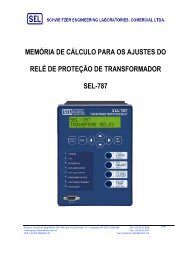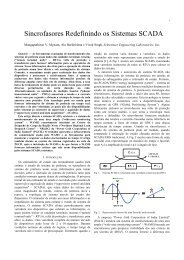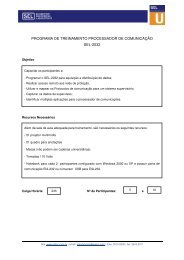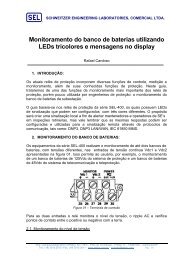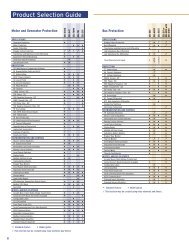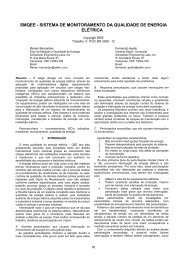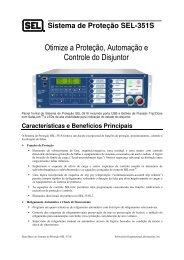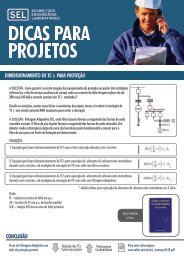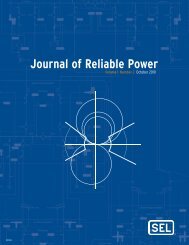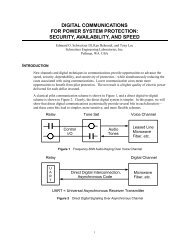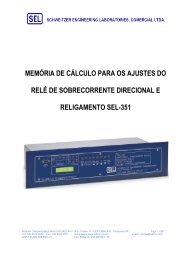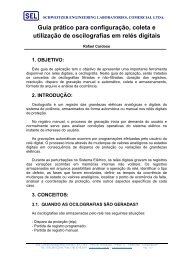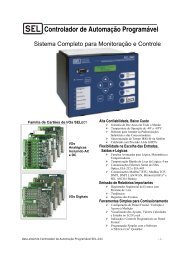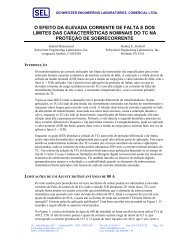Journal of Reliable Power - SEL
Journal of Reliable Power - SEL
Journal of Reliable Power - SEL
You also want an ePaper? Increase the reach of your titles
YUMPU automatically turns print PDFs into web optimized ePapers that Google loves.
10<br />
Fig. 18 illustrates some <strong>of</strong> the these considerations. Short<br />
lines present sufficient margin to accommodate the inner and<br />
outer zones together with any type <strong>of</strong> distance element, such<br />
as a quadrilateral distance unit, following the above<br />
guidelines. Long transmission lines, however, may not allow<br />
sufficient margin. Engineering judgment should be used to set<br />
the inner and outer zones, as well as the resistive reach <strong>of</strong> the<br />
quadrilateral element.<br />
When determining the setting parameters, it may be very<br />
difficult to cover all possible scenarios <strong>of</strong> instability with a<br />
simple two-source model. Therefore, transient studies will be<br />
needed to understand the effectiveness <strong>of</strong> the scheme in<br />
Fig. 18.<br />
Recently, a power swing detection algorithm was proposed<br />
that requires little information from the user [18]. This<br />
algorithm will detect and declare a power swing based on the<br />
estimation <strong>of</strong> the swing center voltage (SCV), which is the<br />
voltage at the electrical center <strong>of</strong> a two-source model. This<br />
voltage can be estimated with local measurements and its<br />
behavior used to detect an out-<strong>of</strong>-step condition. The<br />
advantage <strong>of</strong> this methodology is that no network information<br />
is required.<br />
D. Series Capacitor Applications<br />
It is common to apply directional comparison relaying<br />
systems in the protection <strong>of</strong> series-compensated transmission<br />
lines. Protective relays intended to protect these lines should<br />
be designed to accommodate the changing measured<br />
impedance (because <strong>of</strong> the MOVs [metal oxide varistors] and<br />
spark gaps in parallel with the capacitor bank) and<br />
subsynchronous voltages and currents that are characteristic <strong>of</strong><br />
series capacitor-compensated systems [19]. Moreover,<br />
protective relaying systems located in adjacent lines should<br />
reliably determine the direction to a fault.<br />
For distance elements that are polarized with voltage, like<br />
mho distance elements, the voltage inversion because <strong>of</strong> the<br />
series capacitor is properly handled with memory voltage<br />
[19][20]. Moreover, directional elements determine the correct<br />
direction to the fault [21].<br />
Identifying the fault direction is important to keep the<br />
reactance and resistance lines <strong>of</strong> the quadrilateral distance<br />
element from operating improperly. An impedance-based<br />
negative-sequence polarized directional element (or an<br />
alternate zero-sequence polarized element for ground faults)<br />
will properly determine the direction to the fault, unless a<br />
current inversion is present. Depending on the location <strong>of</strong> the<br />
capacitor bank and the location <strong>of</strong> the voltage transformers<br />
(VTs), suggested settings for the directional thresholds (Z2F<br />
and Z2R) can be found in [20] and [21]. For the impedances<br />
<strong>of</strong> the compensated system in Fig. 19, the directional element<br />
threshold Z2F should be set to:<br />
(ZL1 − XC)<br />
Z2F ≤ (17)<br />
2<br />
Setting this threshold as close to the origin as possible will<br />
ensure proper directional determination, unless a current<br />
reversal is possible in the power system.<br />
jX<br />
–jXC<br />
ZL1<br />
Fig. 19. Series capacitor applications<br />
Uncompensated<br />
Compensated<br />
In Fig. 19, the perspective <strong>of</strong> a long line is shown. Seriescompensated<br />
lines are long lines that require compensation to<br />
transfer more power. There are no short lines compensated<br />
with series capacitors. Also, in the vicinity <strong>of</strong> a series<br />
capacitor installation, subsynchronous oscillations <strong>of</strong> the<br />
voltages and currents are possible [19][20][21]. While the<br />
filtering in protective relays is very good at eliminating highfrequency<br />
components, the filtering is not efficient at<br />
eliminating lower frequencies. These subsynchronous<br />
transients, shown as impedance oscillations on the apparent<br />
impedance plane, eventually converge on the true apparent<br />
impedance, as illustrated in Fig. 20. This figure also shows<br />
that distance element overreach is a possibility.<br />
jX<br />
Z1L<br />
–jXc<br />
Fig. 20. Subharmonic frequency transients can cause distance elements to<br />
overreach<br />
R<br />
R<br />
74 | <strong>Journal</strong> <strong>of</strong> <strong>Reliable</strong> <strong>Power</strong>



